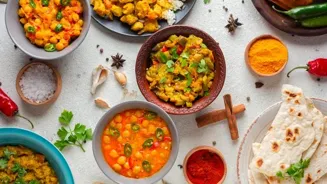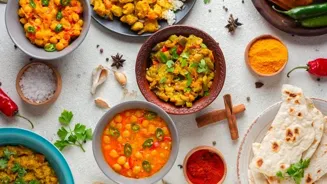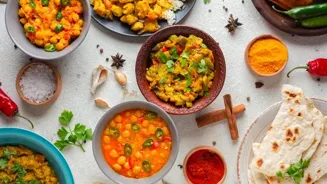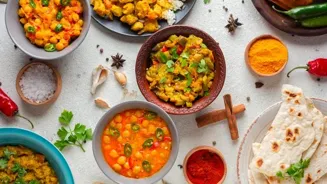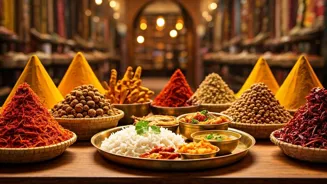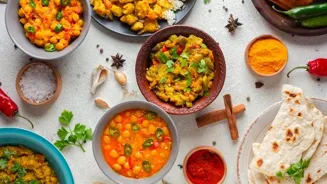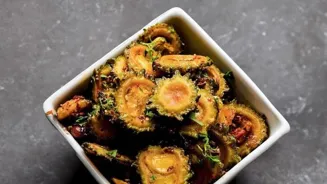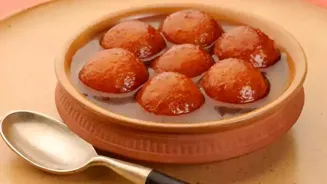Unveiling India's Street Food Evolution. Dive into the history of iconic flavors!
India, a land of vibrant culture and diverse traditions, is also a paradise for food lovers. From the snow-capped mountains
of the Himalayas to the sun-kissed beaches of the south, every region boasts its own unique culinary delights.
And perhaps nowhere is this diversity more evident than in the bustling streets, where vendors hawk an array of mouth-watering snacks and treats. Street food is not just about satisfying hunger; it's an experience, a celebration of flavors, and a reflection of the country's rich history.
Let's take a delicious journey through time and uncover the stories behind some of India's most beloved street foods.
Pani Puri: Iconic Indian street food with mysterious origins and regional variations
Pani Puri, also known as Gol Gappa or Puchka in different parts of the country, is arguably the king of Indian street food. These tiny, crispy spheres filled with a tantalizing mixture of spiced water, potatoes, chickpeas, and chutneys are an explosion of flavors in every bite.
While the exact origins are shrouded in mystery, most food historians believe that Pani Puri originated in the Magadha region of ancient India, which corresponds to present-day southern Bihar. One popular legend attributes its invention to Draupadi, the wife of the Pandavas in the epic Mahabharata.
During their exile, Draupadi was challenged to feed her five husbands with limited resources. Using her ingenuity, she created a dish with leftover ingredients, which eventually evolved into the Pani Puri we know and love today.
Another theory links Pani Puri to a snack called "Phulki," which was popular in North India during the Vedic period.
Over time, different regions added their own unique twists to the recipe, resulting in the myriad of variations we see today, from the spicy Pani Puri of Mumbai to the sweet and tangy Puchka of Kolkata.
The Samosa: An Indian street food with Middle Eastern origins
The Samosa, that golden-fried, triangular pastry filled with spiced potatoes and peas, seems as Indian as can be. Surprisingly, its roots lie far beyond the borders of the subcontinent.
The Samosa's ancestor is believed to be the "Sambosa," a savory pastry that originated in the Middle East during the 10th century. Traders and travelers brought the Sambosa to India along the ancient Silk Road.
The dish gradually gained popularity and was adopted by the royal kitchens of the Delhi Sultanate. During the Mughal era, the Samosa became a staple of the imperial feasts.
Over time, Indian chefs adapted the recipe to suit local tastes, adding spices like cumin, coriander, and turmeric to the filling. The pastry crust was also modified, using maida flour instead of the traditional wheat flour.
Today, the Samosa is a beloved street food across India, enjoyed with chutneys, yogurt, or simply on its own. Its versatility has also led to countless regional variations, with fillings ranging from paneer and vegetables to even noodles and chocolate!
Bhel Puri, a Mumbai street food staple with origins in Jhalmuri
Bhel Puri, a crunchy, tangy, and spicy snack made from puffed rice, sev (crispy noodle-like strands), chopped onions, tomatoes, and chutneys, is synonymous with the bustling beaches of Mumbai.
While its exact origins are debated, most food historians agree that Bhel Puri originated in Mumbai in the mid-20th century. It is believed to have evolved from a simpler snack called "Jhalmuri," which is popular in West Bengal. Jhalmuri consists of puffed rice, spices, and mustard oil.
Some theories suggest that street vendors in Mumbai added ingredients like sev, chutneys, and potatoes to the Jhalmuri, creating the Bhel Puri we know today. The dish quickly gained popularity due to its affordability, portability, and delicious taste.
Today, Bhel Puri is a staple of Mumbai's street food scene, enjoyed by people of all ages and backgrounds. It is often served in a paper cone, making it easy to eat on the go.
Variations of Bhel Puri can be found across India, with different regions using local ingredients and spices to create their own unique twists.
Origin and evolution of Dosa in South Indian cuisine
Dosa, a thin, crispy pancake made from fermented rice and lentil batter, is a staple of South Indian cuisine. Its origins can be traced back to the ancient Tamil country, which encompasses present-day Tamil Nadu, Kerala, Karnataka, and Andhra Pradesh.
According to historians, Dosa originated in the town of Udupi in Karnataka, sometime around the 5th century AD. The earliest form of Dosa was likely a simple pancake made from rice flour and water. Over time, lentils were added to the batter, creating a more nutritious and flavorful dish.
South Indian diaspora carried the Dosa to other parts of India and the world. It has gained immense popularity not only for its taste but also for being a gluten-free and vegan-friendly option.
Today, Dosa is enjoyed worldwide, with countless variations ranging from the classic Masala Dosa to the innovative Chocolate Dosa.
Aloo Tikki: Popular North Indian street food with spicy potato patty
Aloo Tikki, a golden-brown potato patty filled with spices and deep-fried to perfection, is a popular street food in North India. Its history is somewhat less documented compared to other street foods, but it is believed to have originated in the state of Uttar Pradesh.
Some food historians suggest that Aloo Tikki evolved from a simpler potato preparation that was commonly made in North Indian households. Street vendors likely adapted the recipe, adding spices and frying the patties to enhance their flavor and texture.
The dish quickly gained popularity due to its affordability and satisfying taste. Aloo Tikki is often served with chutneys, yogurt, and onions, making it a complete and flavorful snack. It is a staple of street food stalls and dhabas across North India, and is enjoyed by people of all ages.
Idli: Healthy South Indian breakfast with ancient origins
Idli, a soft and fluffy steamed cake made from fermented rice and lentil batter, is a healthy and nutritious breakfast staple in South India. Its origins can be traced back to Indonesia, where a similar dish called "kedli" was popular.
Historians believe that Indian cooks, who had travelled to Indonesia, adapted the kedli to create the Idli. The earliest mentions of Idli in Indian literature date back to the 12th century. Initially, Idli was made only with rice flour.
Over time, lentils were added to the batter, creating a softer and more nutritious dish. Idli is typically served with sambar and chutney, making it a complete and satisfying meal. Its steamed preparation method makes it a healthy and light option, perfect for breakfast or a light snack.
